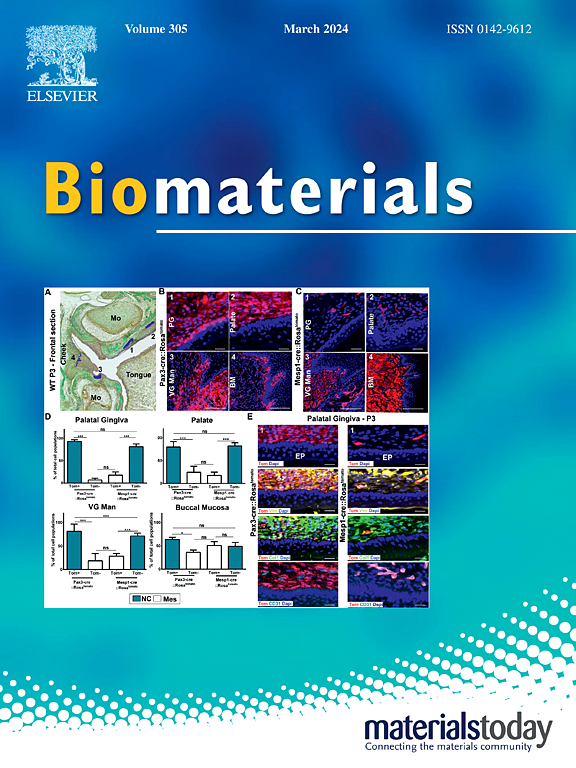Self-assembled hADSCs/hNSCs spheroids combined with 3D printed M-shaped GelMA/Pu Scaffolds: Creating histologically biomimetic engineered cartilage that meets the characteristics of alar cartilage
IF 12.9
1区 医学
Q1 ENGINEERING, BIOMEDICAL
引用次数: 0
Abstract
Background
Traditional cartilage grafts for nasal alar retraction repair often lack sufficient elasticity and histocompatibility, leading to suboptimal clinical outcomes. To address this challenge, we developed a biomimetic engineered cartilage scaffold that combines self-assembled human adipose-derived stem cell (hADSC)/human nasal septal chondrocyte (hNSC) spheroids with a 3D-printed M-shaped polyurethane (Pu)/gelatin methacryloyl (GelMA) hybrid scaffold, aiming to replicate the extracellular matrix (ECM) components and mechanical properties of native alar cartilage.
Methods
The M-shaped scaffold was designed based on clinical CT reconstruction and fabricated via 3D printing using Pu for optimal elasticity. hADSCs and hNSCs were co-cultured at varying ratios (0:5–5:0) and loaded as spheroids into GelMA-coated scaffolds. ECM components (Col-1, Col-2, ACAN, Elastin) were analyzed via RT-qPCR and immunohistochemistry. Subcutaneous (nude mice) and in-situ nasal (sheep) implantation models evaluated chondrogenic performance, ECM deposition and structural integration over 1–2 months.
Results
Through comparative analysis of extracellular matrix (ECM) components among human alar cartilage, nasal septal cartilage, auricular cartilage, and costal cartilage, we identified the target ECM profile for biomimetic alar cartilage engineering. It was verified that self - assembled spheroids have stronger chondrogenic abilities. Among them, the ECM secretion of 80 % hADSCs/20 % hNSCs spheroids was closest to that of alar cartilage. In vitro and in vivo experiments on the M-shaped spheroids-laden Pu/GelMA hybrid scaffolds showed that the secretion levels of key ECM proteins were similar to those of natural alar cartilage. 3D surface imaging confirmed that the scaffold could provide precise alar - nasal tip contour subcutaneously, and no contracture was observed. MRI confirmed the stability of the scaffold in nude rats and sheep, as well as its seamless integration with host nasal tissues.
Conclusion
By prioritizing ECM component regulation through cell ratio optimization and spheroid culture, this study establishes a histologically biomimetic scaffold that faithfully recapitulates the biochemical and structural complexity of alar cartilage. The approach offers a promising alternative to traditional grafts for nasal reconstruction.

自组装hadsc /hNSCs球状体结合3D打印m形GelMA/Pu支架:创建符合鼻翼软骨特征的组织学仿生工程软骨
传统的鼻翼后缩修复软骨移植往往缺乏足够的弹性和组织相容性,导致临床效果不理想。为了解决这一挑战,我们开发了一种仿生工程软骨支架,将自组装的人类脂肪源性干细胞(hADSC)/人鼻中隔软骨细胞(hNSC)球体与3d打印的m形聚氨酯(Pu)/明胶甲基丙烯酰(GelMA)混合支架相结合,旨在复制天然鼻翼软骨的细胞外基质(ECM)成分和机械性能。方法在临床CT重建的基础上设计m型支架,采用弹性最佳的Pu材料进行3D打印制备。hADSCs和hNSCs以不同比例(0:5-5:0)共培养,并以球体形式加载到gelma包被支架中。通过RT-qPCR和免疫组织化学分析ECM成分(col1、col2、ACAN、Elastin)。皮下(裸鼠)和原位鼻腔(羊)植入模型评估了1-2个月的软骨形成性能、ECM沉积和结构整合。结果通过对比分析人鼻翼软骨、鼻中隔软骨、耳廓软骨和肋软骨的细胞外基质成分,确定了仿生鼻翼软骨工程的目标细胞外基质结构。结果表明,自组装球体具有较强的成软骨能力。其中,80%的hADSCs/ 20%的hNSCs球状体的ECM分泌与鼻翼软骨最接近。体外和体内实验结果表明,m型球体负载Pu/GelMA杂交支架的关键ECM蛋白分泌水平与天然鼻翼软骨相似。三维表面成像证实支架能提供精确的鼻鼻尖轮廓,且未见挛缩。MRI证实了裸鼠和羊支架的稳定性,以及其与宿主鼻组织的无缝整合。结论本研究通过优化细胞比例和球形培养来优先调节ECM成分,建立了一个组织学上的仿生支架,忠实地再现了鼻翼软骨的生化和结构复杂性。该方法为传统的鼻部移植物重建提供了一种有希望的替代方法。
本文章由计算机程序翻译,如有差异,请以英文原文为准。
求助全文
约1分钟内获得全文
求助全文
来源期刊

Biomaterials
工程技术-材料科学:生物材料
CiteScore
26.00
自引率
2.90%
发文量
565
审稿时长
46 days
期刊介绍:
Biomaterials is an international journal covering the science and clinical application of biomaterials. A biomaterial is now defined as a substance that has been engineered to take a form which, alone or as part of a complex system, is used to direct, by control of interactions with components of living systems, the course of any therapeutic or diagnostic procedure. It is the aim of the journal to provide a peer-reviewed forum for the publication of original papers and authoritative review and opinion papers dealing with the most important issues facing the use of biomaterials in clinical practice. The scope of the journal covers the wide range of physical, biological and chemical sciences that underpin the design of biomaterials and the clinical disciplines in which they are used. These sciences include polymer synthesis and characterization, drug and gene vector design, the biology of the host response, immunology and toxicology and self assembly at the nanoscale. Clinical applications include the therapies of medical technology and regenerative medicine in all clinical disciplines, and diagnostic systems that reply on innovative contrast and sensing agents. The journal is relevant to areas such as cancer diagnosis and therapy, implantable devices, drug delivery systems, gene vectors, bionanotechnology and tissue engineering.
 求助内容:
求助内容: 应助结果提醒方式:
应助结果提醒方式:


